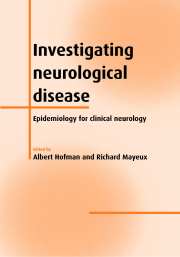Book contents
- Frontmatter
- Contents
- List of contributors
- Preface
- Part I Quantitative methods in clinical neurology
- Part II Neurological diseases
- 10 Cerebrovascular ischemic disease
- 11 Vascular dementia
- 12 Alzheimer's disease
- 13 Parkinson's disease
- 14 Multiple sclerosis
- 15 Myasthenia gravis
- 16 Guillain–Barré syndrome
- 17 Encephalitis and meningitis
- 18 HIV infection
- 19 Prion diseases
- 20 Neoplastic disease
- 21 Cerebral palsy
- 22 Migraine
- Index
22 - Migraine
from Part II - Neurological diseases
Published online by Cambridge University Press: 29 September 2009
- Frontmatter
- Contents
- List of contributors
- Preface
- Part I Quantitative methods in clinical neurology
- Part II Neurological diseases
- 10 Cerebrovascular ischemic disease
- 11 Vascular dementia
- 12 Alzheimer's disease
- 13 Parkinson's disease
- 14 Multiple sclerosis
- 15 Myasthenia gravis
- 16 Guillain–Barré syndrome
- 17 Encephalitis and meningitis
- 18 HIV infection
- 19 Prion diseases
- 20 Neoplastic disease
- 21 Cerebral palsy
- 22 Migraine
- Index
Summary
Epidemiology
Migraine headache is an extremely common and temporarily disabling headache disorder. One recent population-based survey reported that 19% of women and 8% of men had suffered at least one attack of migraine in the previous year. However, only a minority of active migraineurs have seen a physician within the last year for headache (2–4). As a consequence, clinic-based studies are prone to significant selection bias. Population-based studies, which actively screen participants for migraine whether or not they consult physicians, provide more representative samples for research.
A large number of population-based prevalence studies of migraine have been published and summarized elsewhere (5–8). Prevalence has been shown to vary by race, age, gender, and survey methodology (below). A recent meta-analysis suggests that much of the variability in estimates of migraine prevalence is due to the variability of case definitions and sociodemographic profiles of the study subjects. Studies using the IHS criteria showed more consistent results. Table 22.1 presents the results from recent population-based studies that: used IHS criteria and were based on representative populations.
Age
Most studies on migraine prevalence have reported variation by age and gender. Prevalence is generally highest between the ages of 25 and 55, often with a peak in the late 30s and early 40s (10–13). Figure 22.1 (from the American Migraine Study) illustrates this pattern. The strong nonlinear association of age with prevalence accounts for some of the variability in prevalence estimates among studies, due to differing age distributions in the study populations.
Keywords
- Type
- Chapter
- Information
- Investigating Neurological DiseaseEpidemiology for Clinical Neurology, pp. 291 - 306Publisher: Cambridge University PressPrint publication year: 2001

